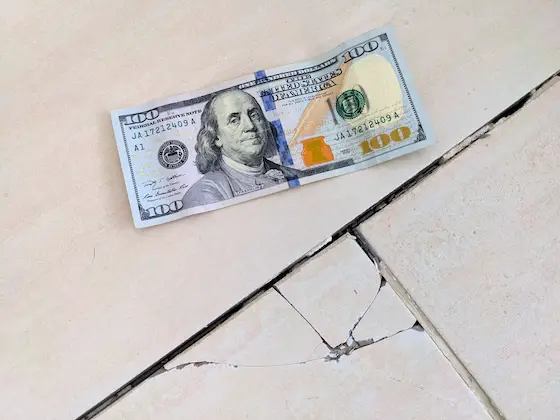Why Do Ceramic Tiles Crack?

An inferior flexing wood-floor system caused the grout to crumble. Once the grout was gone, the tile cracked because it had no lateral support. It’s going to require many of those fancy pieces of paper to repair it. Copyright 2025 Tim Carter
Why Do Ceramic Tiles Crack? - 100% Installation Errors
Ceramic floor tile has a rich legacy as a durable flooring material. You’ve undoubtedly walked across it in countless public buildings. Hotel lobbies, commercial buildings, and even my own previous parish church sported this artificial stone product. The tile in my church was over 100 years old, and it looked perfect, just like the day it was installed. Do you recall ever seeing a cracked tile or missing grout in all of the tile you’ve seen in public buildings? There’s a reason why.
Ceramic tile is quite particular when it comes to installation. You’ll discover one thing all crack-free ceramic tile floors have in common should you be inclined to think about what’s underneath the kiln-fired clay tile. The tile is adhered to a solid base that doesn’t flex. The best bases are constructed to also be crack-free.
Soft Clay Becomes Solid Rock
It’s essential for you to realize the strength characteristics of tile. All ceramic tile is made from pliable clay much like that you used to squish through your toes in a mud puddle after a summer rain shower. Once clay is molded and then fired in a kiln, magic happens. The high temperatures in the kiln rearrange the atoms in the soft clay. New bonds are created transforming the soft clay into a very hard material not unlike rock. In fact, the more silica in the clay, the stronger the tile will be.
Tile is Weak When Bent
Natural rock is very strong when you compress it. It can take many thousands of pounds per square inch of pressure to crack it. However, when you try to bend rock, it’s not nearly as strong. Bending is a tension force that stretches the rock. Rock and ceramic tile often have only one-tenth the strength in tension as they do when compressed.
Keeping in mind how thin most ceramic floor tiles are, you never want the base under the tile to move, nor do you want a hollow space, even as thin as a piece of paper, under a ceramic floor tile. Should this happen, the tile will crack when a concentrated weight is placed on it.
Rookie Restaurant Mistake
Many years ago, before I knew this, I was hired to install ceramic tile in a restaurant kitchen. My only experience at that very young age was using the organic mastic adhesive. This material is not much different than cold cake icing. I installed the tile on top of a crack-free reinforced concrete slab.
The tile looked great when I was finished. A week later, the general contractor called me up, telling me my tile had cracked. The cracks were in the tiles under the feet of the heavy kitchen equipment. The legs of the fixtures were not much different than a woman’s spike high-heel shoe.
The organic mastic under the tile was allowing the tile to bend under the concentrated weight. If I had used cement-based thinset instead of mastic, the tile wouldn’t have cracked. Thinset doesn’t compress like the flexible mastic.
Floor Tile Over Wood Floors
My daughter installed large-format ceramic tile in her home six years ago. I didn’t build this house. The contractor she hired resisted taking my advice about many things. He had a fragile ego and thought he knew better.
The floor trusses were designed to the minimum code standard with regard to allowable flex. You might not realize you can specify how stiff floor trusses can be. The same is true for engineered floor joists or regular dimensional 2x floor joists. You can design wood floor systems to almost be as stiff as concrete albeit it will cost you a significant amount of money to achieve wood floors that don’t deflect like a trampoline.
The second mistake my daughter’s builder made was to rely on ring-shanked nails and adhesive to hold the 3/4-inch subfloor to the wood floor trusses. The subflooring was installed on a cold snowy winter day. I know, as I was there recording it on video. I’m convinced the adhesive in the large tubes was freezing minutes after it was applied to the top of the trusses.
The subflooring should have been screwed to the floor trusses instead of nailed. Several days ago I was walking across her kitchen floor and could hear the subflooring squeak as it moved up and down under each of my footfalls.
It’s no wonder the grout in between my daughter’s floor tiles has crumbled. It’s no wonder at least twenty of her tiles have cracks in them. Her ceramic tile floor is a hot mess.
There is now only way to repair my daughter’s tile floor. You may have the same issue after all. All of the grout must be removed. Cracked tiles have to be replaced. Silicone grout should be used in between each tile. This material remains flexible for its entire life. It doesn’t get hard like traditional cement-based grouts. Cement-based grouts crumble when they flex.
Column 1612